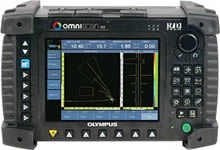Olympus OmniScan MX EC Portable Eddy Current Flaw Detector
Olympus Updated: 2007-09-11Eddy Current Technology
Eddy current (ECT) technology is a noncontact method for the inspection of metallic parts. In this technique, the probe, which is excited with an alternating current, induces eddy current in the part under inspection. Any discontinuities or material property variations that change the eddy current flow in the part are detected by the probe as a potential defect.
Over the years, probe technology and data processing have continuously progressed so that the eddy current technique is now recognized to be fast, simple, and accurate. This is why the technique is widely used in the aerospace, automotive, petrochemical, and power generation industries for the detection of surface or near-surface defects in material such as aluminum, stainless steel, copper, titanium, brass, Inconel® and even carbon steel (surface defect only).
Benefits of Eddy Current
Eddy current offers the following capabilities:
* Quick, simple, and reliable inspection technique to detect surface and near-surface defects on conductive material
* Can be used to measure material electrical conductivity.
* Measurement of nonconductive coating
* Hole inspection with the use of high-speed rotating scanner and surface probe
Eddy Current Probes
R/D Tech's standard eddy current probes are available in different configurations:
* Bolt hole probes
* Surface probes, in various shapes and configurations
* Low-frequency Spot and Ring type probes
* Sliding probes
* Wheel probes
* Conductivity probes
* Speciality probes made for specific applications
Reference standards with EDM notches can be manufactured according to the application specifications.
OmniScan MX Deutsch
OmniScan MX English
OmniScan MX Español
OmniScan MX Japanese
OmniScan PA for Manual Inspection Deutsch
OmniScan PA for Manual Inspection English
OmniScan PA for Manual Inspection Japanese
OmniScan Software 1.4
OmniScan UT for Single-Axis Encoded B-Scan Inspection
Related Manuals
Olympus Nortec 2000D Portable Eddy Current Flaw Detector
Olympus Nortec 1000S Portable Eddy Current Flaw Detector
Olympus OmniScan MX ECA Portable Eddy Current Flaw Detector
Olympus Nortec Rotating Bolthole Scanners
Olympus OmniScan M Entry-Level Phased Array for Manual UT
Olympus Nortec 500 Portable Eddy Current Flaw Detector
Olympus OmniScan MX PA Phased Array Instrument
Olympus BondMaster 1000e+ Portable Ultrasonic Flaw Detector
Olympus TomoScan FOCUS LT Automated Inspections
Olympus OmniScan MX UT Portable Ultrasonic Flaw Detector
Olympus QuickScan PA In-line Inspection Systems
Olympus 1000S+ Portable Ultrasonic Flaw Detector
